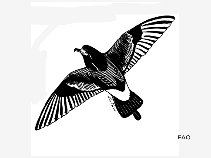Oceanites oceanicus (Kuhl, 1820)
Wilson's storm petrelWarning: DOMDocument::load(): SSL operation failed with code 1. OpenSSL Error messages: error:140770FC:SSL routines:SSL23_GET_SERVER_HELLO:unknown protocol in C:\Apache24\htdocs\includes\SpeciesSummary.lib.php on line 1236
Warning: DOMDocument::load(): Failed to enable crypto in C:\Apache24\htdocs\includes\SpeciesSummary.lib.php on line 1236
Warning: DOMDocument::load(https://sealifebase.nrm.se/webservice/AquaMaps/getAMap.php?genus=Oceanites&species=oceanicus): failed to open stream: operation failed in C:\Apache24\htdocs\includes\SpeciesSummary.lib.php on line 1236
Warning: DOMDocument::load(): I/O warning : failed to load external entity "https://sealifebase.nrm.se/webservice/AquaMaps/getAMap.php?genus=Oceanites&species=oceanicus" in C:\Apache24\htdocs\includes\SpeciesSummary.lib.php on line 1236
Classification / Names Common names | Synonyms | CoL | ITIS | WoRMS
| Procellariiformes | Hydrobatidae
Environment: milieu / climate zone / depth range / distribution range Écologie
. Tropical
Distribution Pays | Zones FAO | Écosystèmes | Occurrences | Introductions
Antarctic, Atlantic and Indo-Pacific. Tropical to polar.
Length at first maturity / Taille / Poids / Âge
Maturity: Lm ? range ? - ? cm Max length : 19.0 cm TL mâle / non sexé; (Ref. 8812); poids max. publié: 38.00 g (Ref. 356)
Description synthétique Morphologie
Culmen: 1.24 cm; tarsus: 3.54 cm; wing: 14.27 cm.
Total Length: 15 to 19 cm; Wingspan: 38 to 42 cm (Ref. 8812). Population is affected by some predation, krill exploitation, and breeding success due to snow blocking burrows (Ref. 84934). Inhabits open ocean (Ref. 81748); found over seas and along shores (Ref. 83946). Exhibits dipping and pattering (Ref. 81748). Skips and hops over water surface while feeding. A colonial breeder. Typically gregarious at sea. Often trail ships (Ref. 91362).
Life cycle and mating behavior Maturité | Reproduction | Frai | Œufs | Fécondité | Larves
Breeds in the Gulf of California, begins in June. Nesting is restricted to rock outcrops and talus slopes, and nests were invariably in rock crevices, occasionally together with black storm petrels.
Référence principale
Références | Coordinateur | Collaborateurs
Lepage, D. 2007. (Ref. 7816)
Statut dans la liste rouge de l'IUCN (Ref. 130435)
Least Concern (LC) ; Date assessed: 07 August 2018
statut CITES (Ref. 108899)
Not Evaluated
CMS (Ref. 116361)
Not Evaluated
Menace pour l'homme
Utilisations par l'homme
| FishSource |
Outils
Plus d'informations
Sources Internet
BHL | BOLD Systems | CISTI | DiscoverLife | FAO(Publication : search) | Fishipedia | GenBank (genome, nucleotide) | GloBI | Gomexsi | Google Books | Google Scholar | Google | PubMed | Arbre de Vie | Wikipedia (Go, chercher) | Zoological Record
Estimates based on models
Catégorie de prix
(Ref. 80766):
Unknown.



